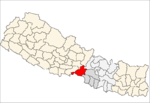Birendranagar, Narayani
| Birendranagar बिरेन्द्रनगर | |
|---|---|
| Village development committee | |
| Country |
|
| Zone | Narayani Zone |
| District | Chitwan District |
| Population (1991) | |
| • Total | 10,482 |
| Time zone | Nepal Time (UTC+5:45) |
Birendranagar is a village development committee (VDC) in Chitwan District in the Narayani Zone of southern Nepal. At the time of the 1991 Nepal census it had a population of 10,482 people living in 1932 individual households. However, the population now increased by more than three times and reached about 30 thousand. This VDC is located in about 150 km from Kathmandu in the south west direction from the capitalcity of Nepal, i.e. Kathmandu. Chitwan is the district where it falls in the eastern part, which is surrounded by six VDCs: Khairahani, Chainpur, Siddhi, Korak, Bhandara and Kathar. It is about two times bigger than Bhandara and Khairahani and similar in area as Chainpur. The village is divided into nine wards, which are further subdivided into one to seven groups.
There are at least four secondary schools in the area: Jana Adarsha Secomdary School, Vidya Memorial School, Bramha Nagar School and Shakura Private school and other which are mostly maintained by the community with little help from the government.
Birendranagar is very rich in resources, as it has a very large area covered by forests, one moderate river ( known as Pumpha Khola) however rest of the other plain area is used for cultivation. This VDC is getting developed now and has provided most of its residents the internet access and cable television as well as good transportation service. This place is a perfect combination of all the castes and faces of Nepal where they have been living very peacefully.
Since 2015 this Village has developed into a municipality called Rapti Municipality, the current municipality includes other 2 villages ( VDCs) namely Bhandara and Piple.
Politically, this place is popular with the CPNUML ( Nepal communist party, unified Marxism and Leninism), the current leader who represents this area is by CPNUML leader Mr. Surendra Panday, who was also a finance minister of Nepal.[1]
References
- ↑ "Nepal Census 2001". Nepal's Village Development Committees. Digital Himalaya. Archived from the original on 12 October 2008. Retrieved 14 December 2008.
